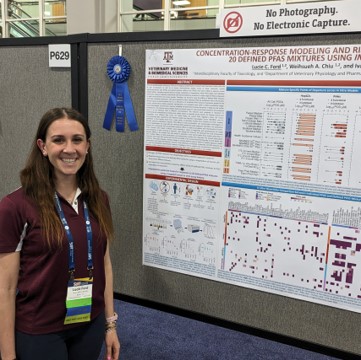Superfund Research Program
April 2024
By Cassidy Rice
Many NIEHS Superfund Research Program (SRP)-funded scientists and trainees, as well as SRP staff, attended the 63rd Annual Meeting and ToxExpo for the Society of Toxicology (SOT), held March 10-14 in Salt Lake City.
SRP Health Scientist Administrator Danielle Carlin, Ph.D., co-hosted sessions that provided multiple perspectives on the NIH grant process, as well as advice for new applicants.

Carlin also hosted sessions on the link between environmental chemicals and neurocognitive disease, and PFAS-mediated metabolic dysfunction. The neurocognitive disease session featured several SRP grant recipients, including:
- Allison Kupsco, Ph.D., from Columbia University SRP Center, presented research on air pollution and cognitive aging.
- Harvard University SRP Center Director Quan Lu, Ph.D., discussed extracellular vesicles as biomarkers of aging.
- Oregon State University (OSU) SRP Center Director Robyn Tanguay, Ph.D., described using zebrafish to detect neurobehavioral toxicants.
SRP Trainees Recognized
SRP trainees were recognized with various poster, session, and travel awards during the meeting:
- Alexandra Noel, Louisiana State University SRP Center, won the Young Investigator Award for the Respiration/Inhalation Specialty Section.
- Han-Hsuan Tsai, Texas A&M University (TAMU) SRP Center, received the Cardiovascular Toxicology Specialty Section Trainee Award.
- Eva Vitucci, Ph.D., TAMU, received the Postdoc Excellence Award for the Regulatory and Safety Evaluation Specialty Section.
- Hsing-Chieh (Candice) Lin, TAMU, won the Biological Modeling Specialty Section 2024 Perry J. Gehring Biological Modeling Endowment Award.
- Lucie Ford, TAMU, received a Graduate Student Travel Award, a Graduate Student Award in the In Vitro and Alternative Methods Specialty Section, and the Top Overall Mixtures Abstract for SOT 2024 Award.

- En-Hsuan Lu, TAMU, received the Perry J. Gehring Graduate Student Award and a Top 9 Abstracts Award, and was a Best Trainee Abstract Award Finalist.
- Haley Moyer, TAMU, received third place for her Graduate Student Poster.
- Mariana Saitas, TAMU, won a Top 5 Abstracts Award in the Exposure Specialty Section.
- Doris Tsai, TAMU, received the EMKA-SCIREQ Graduate Student Award and the Computational Toxicology Specialty Section Abstract Award.
- Keerthana Prayaga, TAMU, received the first place Undergraduate Abstract Award.
- Bingzhen Shang, University of North Carolina at Chapel Hill (UNC) SRP Center, received a Research Award in the Metals Specialty Section.

- Doris Tsai, TAMU, received a Top 3 Poster award from Computational Toxicology Specialty Section.
- Katherine Roth, Wayne State University (WSU) SRP Center, won the Best Abstract Award in the Cardiovascular Toxicology Specialty Section.
- Manisha Agarwal, WSU, received the Dr. Laxman Desai Graduate Student Best Abstract Award from SOT's Association of Scientists of Indian Origin.
- Hannah Starnes, North Carolina State University SRP Center, won the Outstanding Graduate Student Leadership Award from the Graduate Student Leadership Committee.
- Victoria Colvin, OSU, received the In Vitro and Alternative Methods Specialty Section 1st Place Graduate Student Award and the Andreasen Travel Award for Excellence in Research and Scholarship.
- Mackenzie Allison, OSU, won the Molecular and Systems Biology Specialty Section Undergraduate Research Award.
SRP Researchers Awarded
SRP researchers were also recognized for their excellence in mentorship.
Ilona Jaspers, Ph.D., a researcher at the UNC SRP Center, received an Education Award for her leadership in teaching the next generation of toxicologists.
Hollie Swanson, Ph.D., a researcher at the University of Kentucky SRP Center, won an Undergraduate Educator Award for her exceptional mentorship of undergraduate students in toxicology.
For a complete list of all honors and awards recipients at SOT, visit the SOT website.
SOT drew more than 5,000 attendees, and featured more than 70 sessions, more than 2,000 poster presentations, and 250 companies in the ToxExpo.
For more information about NIEHS at SOT, see the Environmental Factor article.


